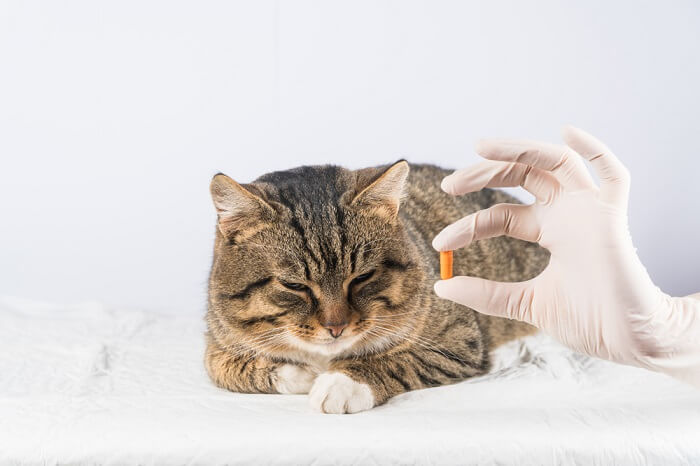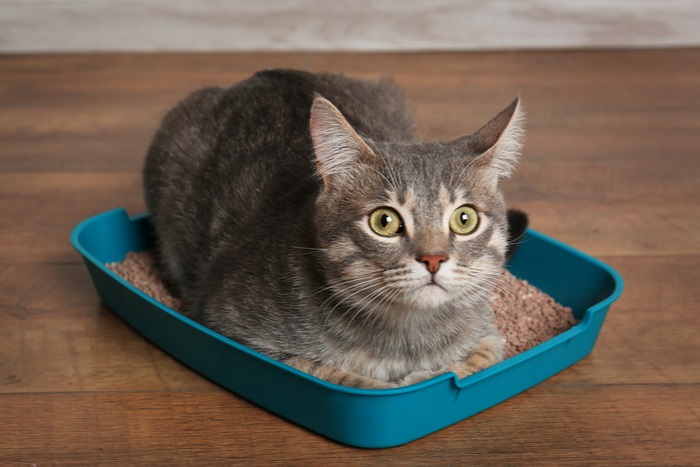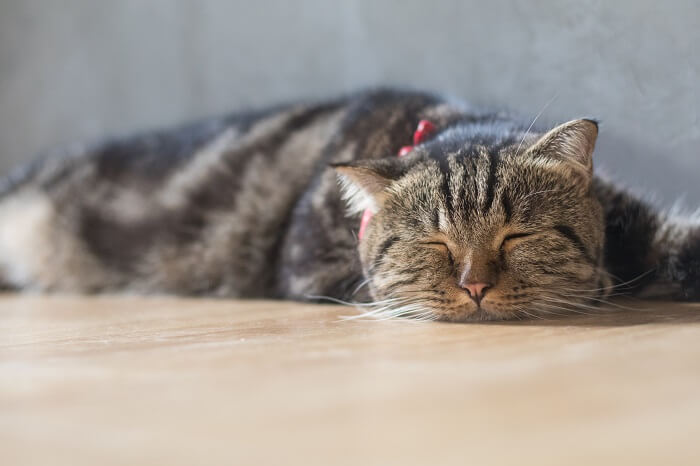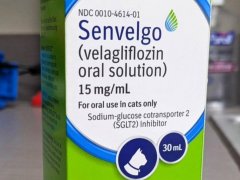
Prazosin is a medication most often used in cats to relieve signs of urinary straining. In this article, you’ll learn what Prazosin is, how it’s used in kitties, some potential side effects, and frequently asked questions.
Prazosin for Cats Overiew

About Prazosin for Cats

Prazosin is an alpha-1 adrenergic blocker. It directly acts as a smooth muscle relaxant. Because blood vessels are lined with smooth muscle, use of prazosin can also lead to relaxation of blood vessels and lower blood pressure.
Prazosin’s most common use in veterinary practice is to relieve urinary straining in cats by relaxing the smooth muscle tone of the urethral sphincter.
Before we continue, please note that if your kitty develops signs of a urinary straining episode, even if he or she has had one or more in the past, it’s always extremely important to notify your veterinarian. It is possible that a cat straining to urinate could have a urethral obstruction or blockage. If a cat develops a urinary obstruction and cannot urinate, this is considered a medical emergency requiring immediate veterinary care.
What Does Prazosin Do for Cats?

Feline Lower Urinary Tract Disease (FLUTD), a syndrome of conditions that lead to difficulty urinating and urinary straining in cats, is very common, especially in male cats.
In cats suffering from stress-induced urinary tract inflammation (also called feline idiopathic cystitis or FIC), urinary crystals, mucousy grit, urinary bladder stones, and other causes of FLUTD, we often find them pushing and straining very hard to pee. The urgent need to pee and straining to do it can often perpetuate the issue, leading to painful spasming of the urethra.
In theory, cats undergoing a FLUTD episode who are straining very hard to urinate, may benefit from prazosin use, as it can help to relax the smooth muscle in the urethra, relieving the urethral spasm and producing a better urine stream, which in turn helps the cat to relax and stop straining so much.
Prazosin use in cats is completely off-label, meaning it is not FDA-approved or labeled for this use. There are few studies available and limited scientific evidence to directly support using it for this purpose.
Veterinarians who prescribe prazosin use it primarily based on anecdotal evidence and personal experience seeing its benefit for feline patients in practice. There are many veterinarians who firmly believe prazosin use in cases of FLUTD episodes or even straining from urinary tract infections makes a big difference in the short term for relieving signs of urethral spasm and the return of comfort for our kitty patients, reducing the duration of individual episodes.
As it does relax the smooth muscle of blood vessels, leading to lower blood pressure, it may also be used primarily as a blood pressure medication for cats with high blood pressure or hypertension, but it is typically not a first-line choice for cats and its use for this purpose is generally uncommon.
Similarly, because lower blood pressure can reduce workload on the heart, it may be used in some cats with severe heart disease or in congestive heart failure. But again, it is not a first-line choice and is used very uncommonly for these purposes.
Side Effects of Prazosin for Cats

Side effects are rare in cats who use prazosin, though an overdose may lead to side effects, with low blood pressure the most common consequence of an overdose.
Side effects of prazosin appear to be uncommon in cats at commonly prescribed dosages, and mostly seem to appear in the cases of overdoses.
While there are no available studies specifically looking at side effects in cats, overdose exposures reported to the ASPCA Animal Poison Control Center between 2009 and 2013 showed low blood pressure as the most common finding, affecting less than half of the about 25 cats reported.
Signs of low blood pressure in a kitty may appear as lethargy, weakness, stumbling/poor coordination, poor appetite, and pale gums, among others.
Also Read: Cat Back Legs Collapsing: Causes, Symptoms, & Treatment
Because of its effect of lowering blood pressure, prazosin should be used very cautiously in cats with existing kidney failure, cats with pre-existing low blood pressure, or cats with hypertension already on one or more medications prescribed to lower blood pressure.
Gastrointestinal side effects like vomiting, diarrhea, and decreased appetite do not appear commonly, but have been reported.
Prazosin for Cats Dosage

The appropriate dosage of prazosin for your cat will depend on their unique situation. Follow your veterinarian’s instructions to ensure that your cat gets the right amount.
The dosage of prazosin for cats is variable and usually based on a veterinarian’s experience using it, which is why it’s important to follow your vet’s instructions when this is prescribed for your kitty.
While dosage ranges may go up to 2mg per cat per day, anecdotally there appears to be little benefit above 1mg per cat per day and some vets use lower doses than that. It is common for the daily dose of prazosin to be given once a day or split into at least two doses.
Though protocols can vary, prazosin is most often only used short-term to help relieve a current urinary episode. This is usually for about 5-7 days.
Long-term use and as a preventative for urinary tract signs and straining in cats has not proven to be beneficial. A study from 2017 from the Journal of Veterinary Emergency and Critical Care did not find any evidence to support its use as a long-term preventative therapy.
Prazosin only comes in a powdered capsule form as a generic or the human brand Minipress. The capsules can typically be opened with the powder sprinkled and mixed with canned or soft food. Only the 1mg capsules are typically prescribed, as any dosages above this per day are unlikely to have more beneficial effects and can increase the risk for side effects.
In order to make dosing easier or more specific for some cats, some veterinarians may have prazosin compounded into liquid form or smaller dosage tablets.
Conclusion

In practice, prazosin may be beneficial to help relieve signs of urinary straining in cats. There has been some more recent debate about its use for this purpose, especially in male cats, because of limited studies and evidence, but it does appear to be relatively safe to use at commonly-prescribed doses. Many veterinarians feel prazosin can really help symptomatic kitties and are confident in its use.
Drug Dosing Disclaimer: We are only able to provide doses for medications that are FDA approved for use in cats and only as the label guidelines dictate. For medications that are used off-label we can only provide guidelines and safety information for use. Safe and appropriate dosing for off-label medications can only be determined by a primary care veterinarian.
We encourage you to work with your veterinarian to determine if a particular medication is appropriate for your cat. Changing or adjusting a dose for your cat on your own without consulting with a veterinarian can carry risk. We do not encourage use of medications prescribed for human use in pets without first consulting with a primary care veterinarian.
Frequently Asked Questions
What is Prazosin for Cats Used For?
Prazosin is most commonly used in cats to help relieve signs of urinary straining by relaxing the smooth muscle in the urethra. Urinary straining in cats can be common with urinary tract infections as well as the various presentations of feline lower urinary tract disease (FLUTD), including stress-induced urinary tract inflammation (called feline idiopathic cystitis or FIC), urinary crystals, mucus and sediment grit, and urinary bladder stones.
Urinary straining can sometimes be a sign that a cat has a full urethral obstruction or blockage. Prazosin is not used to relieve urinary obstructions, and these cases always require immediate veterinary care.
How Long Should a Cat Take Prazosin?
While used off-label and having varying dosing protocols, prazosin is most often only used for a short time period, of a week or less. While many vets find short-term use to be beneficial to help relieve straining during active episodes, a study from 2017 from the Journal of Veterinary Emergency and Critical Care did not find any evidence to support its use as a long-term therapy to actively prevent urinary straining episodes from happening.
What are the Side Effects of Prazosin for Cats?
Side effects appear to be uncommon with prazosin when used at commonly-prescribed doses. The same 2017 study in the Journal of Veterinary Emergency and Critical Care found no significant side effects in about 50 cats prescribed 0.5mg per cat per day. It is typically uncommon to see dosing over 1mg per cat per day.
Side effects seen are most often with overdoses, and signs of hypotension, or low blood pressure, were most common. Low blood pressure in a cat could appear as signs of lethargy, weakness, decreased appetite, stumbling/poor coordination, and pale gums, among others.
Because of its effect of lowering blood pressure, prazosin should be used very cautiously in cats with existing kidney disease, cats with pre-existing low blood pressure, or hypertensive cats already on one or more medications prescribed to lower blood pressure.
Is Prazosin Safe for Cats?
While prazosin is a human medication used off-label and there are limited safety studies available, it is typically appreciated to be safe to use in cats at commonly prescribed doses.
The 2017 study in the Journal of Veterinary Emergency and Critical Care found no significant side effects in about 50 cats when prescribed 0.25mg every 12 hours for one month.








Like an earlier commenter, my cat was put on Prazosin (0.5ml every 12 hours for 7 days) after an obstruction and started peeing small dribbles in his litter box and around the room where we isolated him almost like he was incontinent, he seemed exhausted from days of such peeing so we brought him back to the emergency hospital where they confirmed he had reobstructed. I took my concerns to the Internet where I actually found other pet owners whose cats experienced this EXACT same issue on Prazosin, and some vets they consulted with actually discouraged using Prazosin and even referred to recent studies that showed it was not only ineffective compared to placebo but that cats on the medicine had experienced higher rates of reobstruction. These vets instead recommended NAISD’s to treat the inflammation instead (though there are related kidney dangers).
The hospital has discharged my cat, but they’ve put him on Prazosin again and are strict about following the established protocol which they advised against deviating from despite my findings. Now I’m not sure what to do, I’m genuinely afraid that if I follow their advice and use the medication it may cause a reobstruction. How reliable are the recent studies that show it’s ineffective? They can easily be found on PubMed searching “prazosing cat obstruction”.
Hi Jerry,
I’m sorry to hear about what you’re going through with your cat. Everything surrounding feline lower urinary tract disease in cats and urinary obstruction can be very difficult and frustrating.
This is a general summary of the research data going back to 2013 as it relates to prazosin use for cats with urinary obstruction.
In the Journal of the American Veterinary Medical Association in 2013, researchers did a retrospective study where they evaluated medical records for about 200 cats. Their goal was to compare prazosin to another drug, phenoxybenzamine. Prazosin came out on top in this study with 7% of cats reobstructing at 24 hours and just under 20% at 30 days. The phenoxybenzamine percentages were higher in both cases.
In 2017, in the Journal of Veterinary Emergency and Critical Care, researchers compared 47 cats on either prazosin or a placebo after urinary obstruction. In this study, they found no difference in outcomes between cats on prazosin or cats on a placebo. They did consider it to be a small study size.
In 2021, in the Journal of Feline Medicine and Surgery, researchers compared about 65 cats on either prazosin vs. a placebo. Statistically speaking, they found no difference between cats in either group. On average, reobstruction occurred in about 25% of all cats. Cats on prazosin reobstructed slightly more often and cats on placebo slightly less. This was also considered a small study size.
The 2022 study you mention published in the Journal of the American Veterinary Medical Association evaluated medical records for about 300 cats receiving prazosin and about 85 not receiving it, all following urinary obstruction. In the prazosin treatment group, about 24% of cats reobstructed within 14 days after hospital discharge, compared to 13% with the placebo group.
The authors for this most recent study suggested that the reason prazosin may not work is that it only causes relaxation of smooth muscle. A cat’s urethra has smooth muscle in only the earliest ¼ to a ⅓ of its length. A majority of obstructions are thought to occur more towards the end of the urethra, which is composed of skeletal muscle which is not affected by prazosin.
As far as why cats on prazosin may obstruct more often, the authors had only a couple of theories. One was that the stress of administering prazosin to a cat may contribute. The second was that side effects of prazosin including digestive upset and low blood pressure may contribute. The third was that pet owners may not have been administering the prazosin properly, rendering it ineffective yet associating it with a higher risk of reobstruction (a paradox of sorts).
The authors cited a limitation to their study in that comparing a group of 300 cats to a group of 85 cats may have some inequalities.
A limitation that I would see is that the method of administration of prazosin to cats was not discussed. Pilling a cat can always be stressful and sources of stress should always be avoided in these cats, but in my experience, prazosin capsules can be opened and sprinkled/mixed with food, which should not be stressful.
They also could not elaborate further on how hypotension might contribute to reobstruction. GI upset side effects could, if the side effects cause stress in the cat.
Statistically speaking however, the results currently point to prazosin not being as beneficial as previously thought to prevent previously blocked cats from reblocking. The 2022 researchers seemed to indicate that there was no clear reason why prazosin would actually cause reobstruction, but its highlighted lack of efficacy in reducing reobstruction risk also highlights the need we still have for something that can be confirmed to help.
The problem with urinary obstruction in cats is that ¼ to ⅓ of cats will reblock no matter what we do, and while there are some better standards of care compared to others, there is no definitive therapy to date that can universally reduce the risk of reobstruction. If a cat on prazosin reblocks, is it related to prazosin or would it have happened regardless?
Although many vets will use them in the hope that they help (sort of like why we may use prazosin), NSAID use has not been associated with any improved outcomes either. And neither have steroids.
What we’re left with is knowing cats with lower urinary tract disease are painful and at least treating with pain medication like buprenorphine or gabapentin helps them with comfort level.
In my own opinion, I would feel that if administering prazosin is not stressful to a cat, GI upset side effects are not being seen, significant hypotension is not present, and an effective (but not stressful) way of giving the medication is being used, it’s not clear how prazosin would contribute to reobstruction.
But for now, until more research comes out, the current research shows prazosin should perhaps be avoided following obstruction with the goal of preventing recurrence.
Keep in mind that prazosin may still be used in other situations with urinary difficulty or straining in cats where urinary obstruction has not occurred.
Keep in mind too, that there are many other factors that have been recognized to increase risk for reobstruction, including things like difficulty placing a urinary catheter, how long an indwelling urinary catheter is in place for, how “gritty” or turbid the urine is at the time of blockage, and others.
I hope all this information is helpful and I wish your kitty a full recovery.
Thank you so very, very much for such a thorough and comprehensive breakdown Dr. Vanderhoof, we’re canvassing the opinions of other veterinarians and your input will definitely be helpful in our decision-making going forward. Crossing my fingers that our kitty will pull through.
Sorry I just thought to ask, if we forgo Prazosin in order to avoid reobstruction again, what therapies/treatments would be recommended instead? One veterinarian I spoke with for a second opinion recommended daily subcutaneous fluids along with either robenacoxib or meloxicam for pain relief (though you’ve already pointed out that there’s no experimental evidence to support the use of such NSAIDs), with of course a wet urinary prescription diet.
Thank you so much again for bringing your expertise and insight to bear on this issue.
Hi Jerry,
Therein kind of lies our problems with managing these patients after they’re out of the hospital (or even sometimes while they’re still there). While research evidence for prazosin and NSAIDs may be lacking, there is nothing better proven to replace them. Generally, increased water intake appears to be the thing we try to focus on that may help the most. This makes sense, as increasing diuresis should help to dilute out sediment and mucus that can contribute to obstruction. Increasing amounts of canned food is the best way to increase water intake. Having an “attractive” source of water, like a fountain, can help too. The prescription urinary diets can help, especially in cases where mineral sediment, grit, or stones may be related. Subcutaneous fluids wouldn’t be wrong as they can also provide hydration and diuresis, but just so long as the stress of administration does not cause complications. FLUTD generally is linked to stress and we want to minimize stressful events as much as possible.
Can I give prazosin to a 3 pound kitten who is not urinating? She had an ultrasound and X-ray and urinalysis and all were inconclusive.
Hi Barbara, while the inconclusive test results can be frustrating, I would not feel that use of prazosin in such a small kitty would be a good idea. It’s best to use it when we’re reasonably certain that a kitty can urinate, but is just having a difficult time doing so. It is a drug used off-label in cats, and so there is no age-related restrictions per se, but the suggested doses are on the basis for an average adult-sized cat and I would be concerned in such a small cat that there would be more chance for the hypotensive effects to be seen.
My cat was prescribed 1mg every 12 hrs. He is a big cat at 14 lbs. he is literally hallucinating. Non stop trying to pee in every place possible. Crying when he looks at me. Unfortunate there is nothing I can do until it wears off. Of course plenty of food and water. I will never give him this medicine again. Nor recommend anyone to give it to there cat.
Hi Natalie,
I’m sorry to hear your kitty is experiencing urinary problems at home. Prazosin does not have any drug properties that would lead to any hallucinogenic effects. Hypotension (low blood pressure) is sometimes seen in cats as a side effect and dizziness has uncommonly been reported in dogs, though this does not sound like what you’re describing.
However, what you are describing sounds like a cat that is having a frequent urge and need to urinate. Prazosin is often prescribed for these types of signs. But if you’re observing that this behavior has worsened since starting prazosin, my concern wouldn’t be that prazosin is causing it, but that the primary urinary issue is not being addressed by prazosin alone and may be worsening in spite of prazosin use.
If your cat is urinating frequently around the house and vocalizing, this is unlikely to be hallucination but is more likely a worsening urinary condition that could certainly constitute an urgent need to follow up with your veterinarian.
My cat was prescribed 1 MG CAP to be given ONE HALF CAPSULE BY MOUTH EVERY 12 HOURS. This is an impossible task as the powder does not dissolve in any liquid I have tried. Is it possible to give the whole 1 MG CAP EVERY 24 HOURS INSTEAD?
Hi Eve, sorry you’re having some frustrations there with your kitty’s gabapentin. I am assuming by 1MG this means a 100mg gabapentin capsule as this is the most common size dispensed. Typically the powder is best mixed in canned or soft food. I have not encountered clients having success mixing it with water either. If you cannot find a way to mix the contents of 1/2 capsule with a canned or soft food, it would be worth asking your vet about getting the gabapentin compounded into another form like a liquid or a 50mg tablet. I would not give the contents of a whole 100mg capsule to a kitty at one time if 50mg was prescribed. 100mg for most cats will make them very sleepy. Sometimes a higher dose like that is used for travel or vet visits, but not often for daily management of pain or stress.
At the top of the article it says that Prazosin is FDA approved but
later in the article it says it is not FDA approved. Did I misunderstand something?
Hi Mike,
Thanks for bringing that to our attention, as this appears to be an editing error. Prazosin is NOT an FDA approved medication. I’ll alert the editing team to ensure it is corrected in the overview section at the top.
Hi Erin,
Glad that your kitty is recovering!
When it comes to an off-label medication like prazosin, it is best to discuss tapering or discontinuing with the veterinarian who prescribed it for your kitty or otherwise your primary care vet. There is no set or defined tapering protocol for prazosin, so how it is discontinued depends on the intentions of the attending doctor and how at risk they feel a kitty may be of reobstructing.
I have discontinued it abruptly after a short course, but for cats on it longer or at higher risk of reobstructing, tapering may make sense, it just depends on the individual case, and that’s best discussed with a doctor who knows your cat best.
This is typically the kind of question I would discuss with my own clients with a phone call and hopefully your vet would be willing and available to touch base with you briefly since he/she knows your kitty and his history the best.
Kind Regards
Hi Dr Chris,
My cat had an obstruction 4 weeks ago. He has been on 0.25mg Prazosin daily since then. We have 2 tablets left (8 doses) and I have read that cats should not abruptly stop this medication and should be tapered off. Can you advise if this is true and how best to taper off. ie reduce the frequency to every second day or reduce the daily dose to 1/8 tablet.
Hi Erin,
We’re going to forward your comment to Dr Chris so he can get back to you with an answer. All the best to you and your cat.
Can this med cause the cat to leak urine? MY vet had no explanation for the leaking. He has never leaked before just while he is on this med.
Hi Rebecca,
Urine leakage is not a reported effect of prazosin. I personally have not had any clients report this to me either. If it’s something you see consistently and repeatedly only when your kitty is on prazosin, the only thing I could suggest is that as a medication that in theory decreases urethral resistance or helps to relax the urethra if you will, a cat very sensitive to its effects might have too relaxed of a urethra that might lead to urine dribbling. Again, there’s no official reports of such an effect, just my attempt to help make sense of what you’re seeing if it’s truly related to the drug. The purpose of its use in cats primarily is to help reduce tension and spasm of the urethra and allow it to relax. I guess it’s possible it could do its job too well in a rare kitty, but I’ve certainly not heard of it before.
Now, I will also mention that in uncommon cases where a cat develops a urinary obstruction and the bladder muscles get overextended from bladder enlargement, which is called detrusor atony, it is possible to see urine leakage occur because the bladder becomes flaccid and weak. Since prazosin is most often used in cats at risk of urinary obstruction, I could also see how “sudden” leakage from unknown detrusor atony might be blamed on the medication, especially if it’s the first time it’s being used. The effects of prazosin should wear off when it’s not in use, so if your kitty developed urine leakage and it hasn’t gone away even after stopping prazosin, then the urine leakage would likely be from another cause and not from the medication.
Rebecca this is happening to my cat too. After surgery to unblock him. We’re on day 5 post surgery(still on Prazosin) and it is still happening. I see your post was from 2 months ago. Looking to see if the problem cleared up
That was meant to be a question.
Betty
Hi Betty,
If you’re having trouble giving a capsule to a cat, you’re not alone! Usually with prazosin, it’s best to mix the contents of the capsule with canned or soft food, as giving the capsule directly by mouth can be a challenge. If this has already been tried, or if giving the capsule is not feasible, my first move is to get a compounded liquid form of prazosin. This is something your vet could help you with, either through a local compounding pharmacy, or one of the larger ones. This increases the certainty that the right dosage is evenly mixed in the right type of solution and it can usually be ordered in a very small dosage volume, sometimes just 0.5 or 0.25ml. You can even get the liquid flavored, which sometimes makes it just a little bit easier to give to a disagreeable kitty.
Barring that though, you can certainly mix the contents of the capsule with a small amount of water. It shouldn’t be given with too much water, no more than 1-2ml, and should be given right after mixing with water to keep any of the powder from settling out. It’s usually best to give it directly by mouth, which it sounds like you have experience with, as I don’t feel that squirting the solution on food is as effective. And if mixing the powder with canned food doesn’t work for the more discerning cat, squirting the powder solution on some food likely won’t either.
I hope that helps!
can I dissolve prazosin 1mg capsule in liquid and dispense with mini plunger? My cat is VERY fractious! I can succiessfully dose him with liquids. Thank you